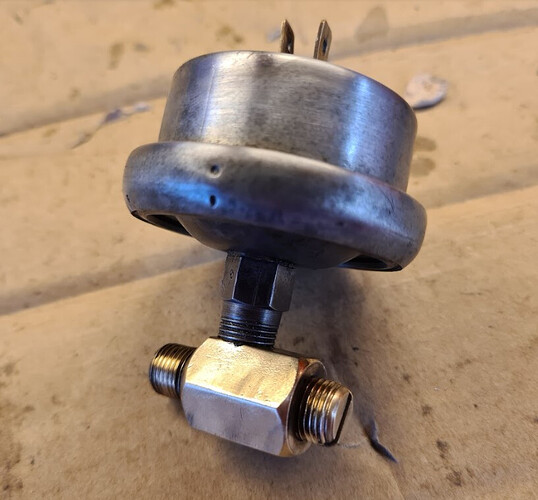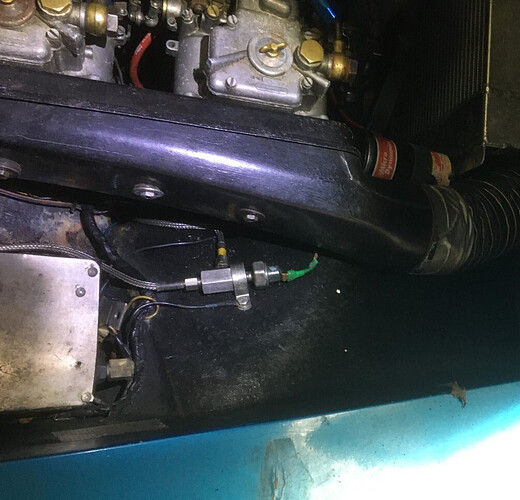What is the purpose of the slotted screw on the adapter for the oil pressure sender ?. There doesn’t appear to be any internal parts that this would effect. Is it just a blanking plug ?.
An oil pressure gauge is useful.
An oil pressure light is vital !
Your connector can enable both.
![]()
Ok, my gauge is electric not mechanical, receiving an output from this sender is that correct ?. Normally I would expect to see a direct oil feed to the gauge from this adapter but there isn’t one.
I originally had a capillary gauge. I thought the response was slow due to the very fine tubing, and the stiff capillary tube very awkward when doing work on the engine or behind the dash.
I then fitted an electric gauge, with a simple cable connection, but found the response slower still.
So I replaced it with a capillary type, and used a larger bore armoured flexible tube, in conjunction with an oil pressure warning light. See pic of the arrangement.
I’m very happy with this arrangement.
![]()
Thanks. So is the electrical gauge the OEM fittment, dependant on year ?, with no warning light ?.
My Plus 2 (15 years old when I bought it ) had a capillary PG, but the orginal workshop manual wiring diagram shows an electric gauge, with no warning light.
![]()
Thanks, so mine is original but flawed. A warning light sounds like a good idea.
Are you running electric fuel pump, can have oil pressure shut fuel too!
I wont have a vehicle without low coolant warning light, probably should have audible too? Same for oil.
I do have an electric fuel pump. I have the wiring and the relay in place, just need to wire a start-up by-pass button.
I have an electric fan running warning light.
Despite all the gauges in the Plus 2, I have on occasion first noticed no oil pressure by the rattling of the bearings, and engine over-heating by the smell. ![]()
Dependent on year. Early cars had mechanical gauge, then switched to electrical and very late cars (~73) went back to mechanical. My guess would be yours is original but connection has been modified for some reason, these might be:
- Positioning of sensor
- Connecting an external oil pressure gauge (likely just for testing)
- Allowing pre circulation of oil before starting engine (after sitting or rebuild)
- sensor for oil pressure light
I doubt it hurts anything, but is just another place for possible oil leak.
Thanks. I’ve never worried about oil pressure warning on any of my other 60s cars so I’m not too concerned. I might consider adding a warning light at some point.
Back in the day we used to call the oil pressure warning light the Too late lamp.
It was still useful though because it told you what had caused all that knocking.
Eric in Burnley
1967 S3SE DHC
I once had a spin on oil filter failure in a crossflow engine. There must have been a tiny flaw in the metal sheet the filter body was stamped out from. A very small hairline crack developed near the bottom of the filter which drained the oil. The engine was totally standard and the pump was totally standard.
I noticed whilst driving at 80km/h the oil warning light coming on. There was no prior warning or prior leakage from the filter. I shut the engine down immediately and it was before I heard any strange noises from the engine.
I managed to knock on the door of a house and they kindly took me to a nearby garage where I was able to buy a replacement filter and oil. Once refilled and the filter replaced I continued on my drive and the engine ran fine.
That engine lasted for many miles after that. When it finally failed (due to the dropping of a valve seat) I dismantled it. All the bearings were perfectly fine apart from a light scoring of the rearmost camshaft bearing - not enough to cause any issues. I attributed that to this incident because this is the bearing furthest and highest from the pump.
Morals of the story:
- If you see the warning light come on shut the engine down immediately. Don’t wait for bearings to rattle. It doesn’t always mean disaster.
- A warning light is more effective than a gauge for alerting of a sudden change in condition.
- An audible warning together with a light would be even more effective.
Good advice, thanks.
On the Elan I race(d) I fitted an oil pressure cut out switch that disabled the electric fuel pump and cut the ignition if the engine lost oil pressure.
This was more of a safety feature, I didn’t want the fuel pump running if I had managed to crash the car (assuming as a consequence the engine had stopped), but it also had the advantage of cutting the engine in the event of oil pressure loss due to other reasons.
In the spirit of ‘fail safe’, a standard oil pressure switch works the wrong way around - it breaks contact when oil pressure is present. So if it was used as a sensor simply pulling the cable off or cutting the cable would indicate oil pressure was present, events that could occur in a crash. To solve this, I fitted a ‘change over’ oil pressure sensor and used the ‘make’ contacts to detect oil pressure. Any failure would lead to an open circuit and cutting the engine.
This has to be overridden at startup (pushbutton on the dash) but does have the advantage of allowing me to crank the engine to get oil pressure before I attempt to start it.
Demon Tweeks used to sell a changeover switch, but don’t seem to stock it anymore. The following link seems equivalent, but is a bit expensive:
As already noted one of the benefits of an oil pressure warning light is because they tend to attract your attention more quickly than a gauge and therefore well worth fitting. It may not fit with the concours rebuild but gives peace of mind.
Most race cars fit a light which often is quite large in size so it is easily spotted and usually well within the drivers line of sight ahead. But on an Elan you perhaps want something a bit more discreet than that, and it is possible to fit another lamp next to the handbrake warning light on the right hand side, but make sure the bulb and colour is bright enough to get your attention.
It is a small mod that costs probably less than a fiver, and certainly less than a £5000 engine rebuild!
Tony
and if you don’t want an extra lamp, fit a buzzer , it’ll keep you awake on those long tight bends…
John ![]()
Thanks folks, I’ll certainly consider adding some form of warning device.
Hi Not sure if you actually got the answer to your question but the grub screw should just be a blanking plug.
I have a +2S but my block has a 1/4" NPT thread whilst my sender is a 100 PSi unit from something else with a 1/2" UNF thread. I’m trying to establish how it’s meant to be as it’s an odd combination to find a common direct adapter.
I have one but the sender can only attach on the end and then runs the risk of the electrical contacts piercing the radiator hose or breaking off - which they have now done.
In trying to find out more I came across your post,
The recommended new sender is 1/8 NPT which will give me more choice for an adapter but the new sender units are physically deeper and seemingly don’t read correctly at lower pressures.
Do you know what sender you have?
The Spares list has Lotus numbers not Smiths.
It should be stamped on the side but appreciate this dialogue was a while ago probably back on your car and hard to access. If known, I can then keep an eye on eBay or a Wanted ad in CLN or here maybe to try and source one.
Thanks
Hi
An interesting thread. I just today wired up the oil pressure warning light on my Zetec Plus 2 Light is in between the tach and speedo and is bright) and am seeking a sender (at a reasonable price) that will work with the standard Smiths gauge. If anyone knows of such a thing please let me know!
I agree that’ll a warning light is more useful/important than a gauge.
All the best
Berni

